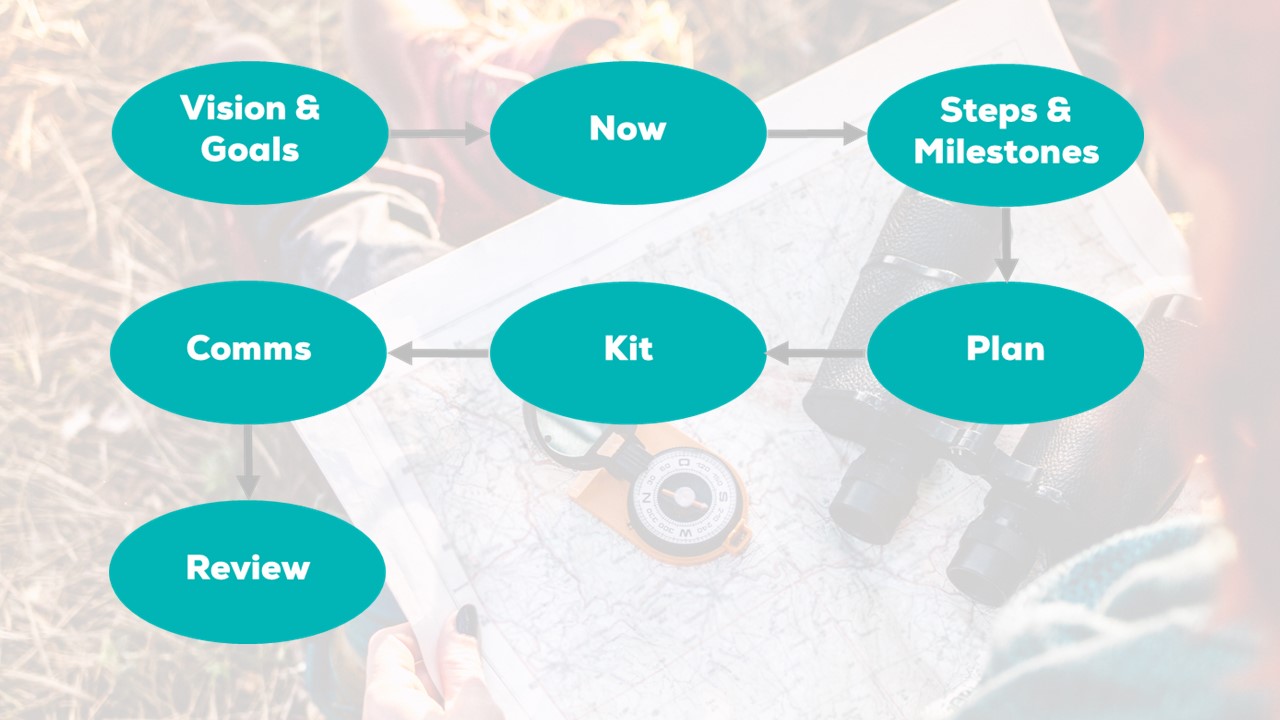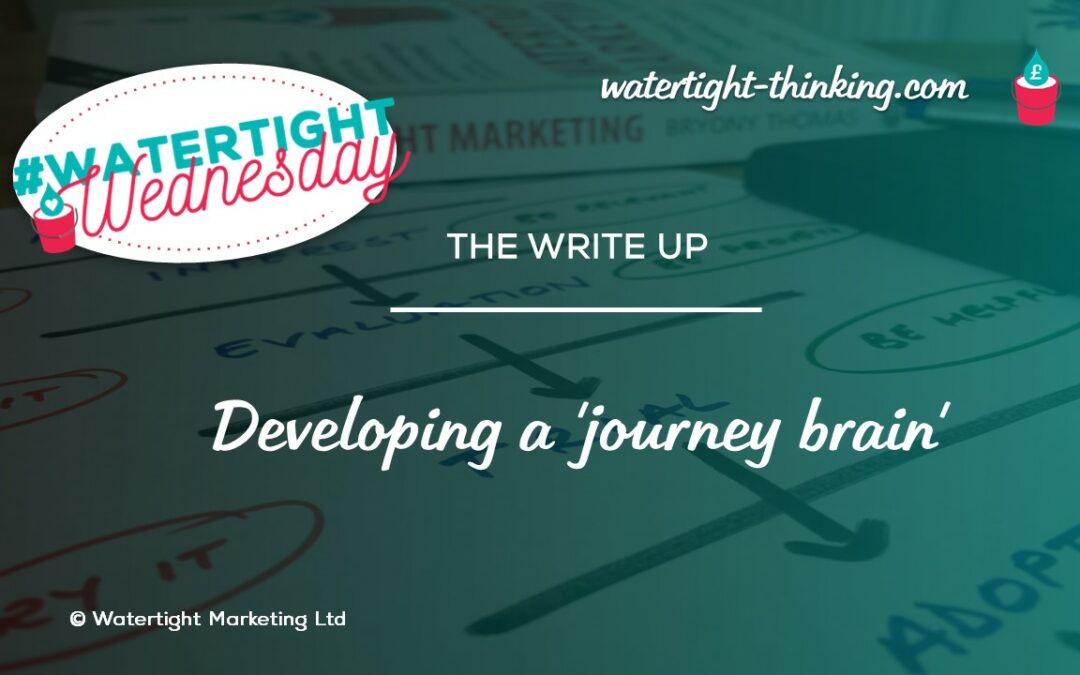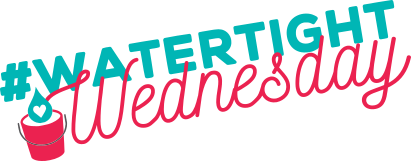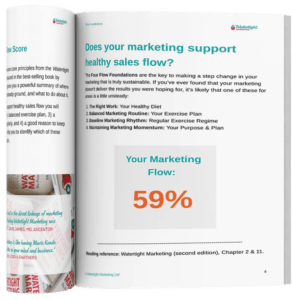Reading Time: 10 Minutes
“Marketers are familiar with the customer journey. It’s the starting point for our thinking, strategies and plans. But what are the other ‘journeys’ in the business – employees, other stakeholders, growth? How can marketing contribute to and enhance these? Our October roundtable explored these different journeys, how to map them out and who needs to be involved in ensuring a consistent and brilliant customer experience.” ~ Rachael Wheatley, Managing Director | Watertight Business Thinking
Listen to the session podcast here
49 -minute roundtable discussion on developing a journey brain.
What does having a ‘journey brain’ mean?
Let’s first define the term. What we mean by having a journey brain is that it’s when people in organisations understand the various journeys that exist in a business. They know what the destination is, where the business is now and the steps needed to reach that destination. They know how to work together to achieve the goals and what part they play in the journey.
As with supporting customer journeys, it’s a team endeavour. It’s not just one team that’s involved, nor should it be.
What are the different journeys?
Apart from the obvious one – customer journeys – the main other one is the employee journey. At the moment, it’s a candidate’s market so it’s critical to properly support a prospective employee’s journey through to job offer and on-boarding if what you want is the pick of the best people, ensure you’re right for each other and new staff who are happy and want to stay.
We named four further journeys: stakeholder, funder or buyer, supplier, growth. And there are many more!
During each journey, there are numerous interactions and a person’s experience of each interaction is important. Even if you turn down a prospective employee for a job, how they view your company as judged by their experience of the recruitment process is as important as it is for staff you employ.
If a funder or buyer is considering investing in your business, it’s a marketing job to help them make a decision with which they remain happy.
For a business’s growth journey, it’s partly the job of internal marketing to ensure staff come along with the leaders.
In fact, not only is it beneficial to split a journey up into chunks, it can also be helpful to see each chunk as a mini-journey in its own right. You can then examine each bit separately. This helps to make sense of complex journeys that have many moving parts and interactions.
Andy Coghlan: “I’ve worked on two journeys recently. One was a customer journey for an entertainment company and the other was a ‘lead to contract to cash’ journey for an agency. For the customer journey example we actually split that into acquisition, the discovery journey (how people discovered different entertainment shows on the website), the show experience, post-show engagement and then loyalty and re-purchase. Against each element we dug deeper and looked at the data to understand: how are we performing, where are the friction points, what’s the impact of people leaving those different stages? We could then begin to quantify it and put KPIs against each stage. It really helped get people talking because you’ve given each mini-journey a name and success metrics.”
Rachael Wheatley: “So, those stages of the journey, the mini-journeys, also become milestones – when we reach this stage, we would expect to see this, and we want the experience to be like that.”
Andy Coghlan: ”Yes, and each of them have sales KPIs, conversion KPIs or value KPIs.”
Why is it a marketing job to support these journeys?
We don’t necessarily see the marketing job here as being one that the marketing team undertakes. It’s taking ‘marketing’ in a very broad sense. Consider our definition of marketing:
“Marketing is the process of supporting someone through to a decision with which they remain happy.”
That decision could be:
- someone considering joining as employee;
- a funder thinking about investing in business;
- a supplier thinking of partnering with you.
All of the journeys need to be mapped out and supported by marketing tools and techniques (though not necessarily by, or only by, the marketing team). For employees, HR would lead. For funders, the CFO and MD might lead.
Mapping the journey
One of the first things involved in developing a journey brain is to map out the journey in question. At a high level this is what’s involved, for any journey.

- Vision: the destination, goals and values which guide your staff’s behaviour and approach.
- Now: get a good sense of where you are now, what do you already have that will help you get to the destination, what’s missing. What insight or research is needed to inform you, what are those on decision journey thinking, feeling, saying, doing at each step of that journey that will help you understand how to better support them?
- Steps and milestones: what’s the route to the end point and how do you know when you’ve reach which stage. What’s the timescale. Be specific – when we get here, we will have x clients, have reached £y turnover, have a fully- resourced team, have funding in place.
- Plan: create a more detailed map of what will be involved, what activity you need to undertake. Manage that plan as you would any project.
- Kit: what tools, processes, systems, tech, materials, knowledge, resources and skills do you have and what’s needed. As with any journey, you need to be properly equipped before you start!
- Communication: critically important, both to engage people in the first place and to keep them up-to-date with progress of any project. Helps them know the destination, get on board with the journey and understand what their contribution will be.
- Review: do this regularly and link to the milestones you’ve set.
Andy Coghlan again: “Mapping the journey was a team endeavour. There’s physically going through the journeys as part of the user experience. We interviewed key stakeholders and customers. We used data and analytics and looked at the metrics. So, a mixture of observational and empirical. This got us to understanding the ‘now’ bit of your diagram. Then we talked about where we wanted to be and what the options were, using measurements to help prioritise the options based on where we felt the best returns will be, ease of implementation and value added.”
Rachael Wheatley: “There’s an advantage in including quite a lot of people in mapping it in the first place because then you’re necessarily helping everyone to understand what their contribution is…. How often would you bring the team together?”
Andy Coghlan: “Monthly, for the steering or leadership group. Then there’s the working groups that might be meeting weekly for a period of time. Whatever works best for the organisation. The name you’ve used – “journey brain” – is just right. It’s about changing the mindset. A lot of it is helping to get people aligned to that way of thinking. And the reason I like to put the commercial aspects behind it is, there’s nothing that gets people aligned more than what it’s worth or costing you!”
Rachael Wheatley: “And what those numbers mean – for instance making life easier for the customer or getting more applications from prospective employees so that we can ensure we have the right skills and people in the business.”
The importance of getting people involved
As employees in a business, we never work in a vacuum. Everyone contributes. For example:
- The IT person knows what tech supports different journeys, whether that’s a CRM or finance system or operational tech that helps people get the job done and delivers great service.
- Customer services people need to know what the customer’s journey to them has involved so they can pick up seamlessly from sales.
- The HR manager needs to understand the person fit and what skills, learning and development is needed so that employees (including new ones) stay happy and motivated.
- The procurement team needs to have a clear view of what kind of suppliers will ensure a productive and warm relationship.
- Managers need to know where their team fits in to the different journeys so they can encourage them to fully contribute and feel they have part-ownership.
Whether people know it or not, these are marketing jobs – because they help someone to make a decision with which they remain happy. So, the more people are involved, the more the business has this journey brain, the happier your customers, users, employees, funders, suppliers will be! This is why we usually involve people outside the marketing team in our transformation programmes – they are much more likely to succeed and get traction.
Good ways of engaging with people to encourage that input:
- Set up cross-functional projects to look at particular journeys that don’t work or need improvement;
- Run sessions mapping out the journey including various people from different teams;
- Identify what support there is in place and where the gaps are and delegate actions to people in the teams.
Andy Coghlan: “What you said about having multiple people involved – it’s critical. The example I usually give is in finance or other regulated industries. If you go to someone in compliance or legal with a solution, it’s their mindset to say, “no”. If you involve them in the process, then they become more creative. They’ll better understand what you’re trying to achieve and say: we can’t do it this way, but actually, if we did this, it might be a way around it. So I think it’s critical to have all those people in the room feeling some level of ownership.”
How you develop a business-wide journey brain – impact and challenges
Maggie Mutkovicova: “Developing a journey brain in my experience is very different if you have 250 people in the business versus one with 10 people. In a bigger business, we have the challenge of getting the message across that it’s ok for them to get involved in, say, the brand experience and they won’t be stepping on our toes. We want their ideas and for them to feel co-ownership! One of the ways we did that was through customers stories – these are the kinds of interactions we had with them and what they thought, and this is how the relationship develops because of that.
”For employees their journey involved asking: what am I signing up to? How am I going to fit here? We showcased that and it was really valuable.”
Maggie Mutkovicova went on to describe her experience of working in a smaller organisation. “On the flip side, there’s a company with 10 people. The challenge here is to take it from one person – the founder – who has his hands in all pies, and disperse that whilst keeping the same quality. So, for instance, handing over recruitment to someone who can take charge of that journey. All of these things are critical to our image and actually quite time-consuming.
“When you’re scaling up, it’s hard to let go. So we’ve started having objectives and key results so people know what we’re measuring – and that gives people the opportunity to say: this is where I see I fit in. Which makes handover easier.
“As a marketer, the biggest challenge is making sure I know what’s going on, keep it running and people engaged. It’s going well, though, mainly because we have people who are eager to help and who genuinely want to get involved. Without that, it would be more difficult.”
Rachael Wheatley: “What kind of mindset do you think is needed? And how do you encourage people to be open to change and to contribute?”
Melanie Osborne: ”It is a challenge. Our people team really got on board with it from an employee recruitment journey. We’ve done a lot of work there to look at how the journey goes and what tools we can use at what stages. We’re now seeing the dividends of that work in that we’ve got virtually no vacancies. That’s never happened before. We’re not finding recruitment an issue at all at the moment, to the point where people who have been turned down for jobs at second interview are now hanging on for the next job. And we’ve got a process now of keeping a note of those people who we thought were good, but not right for that role but could be for the next contract. It’s amazing. I mean, I never considered that people who we turned down would still want to work for us.”
Rachael Wheatley: ”How long did it take for that to happen? To see the effect of the HR team developing that journey brain?”
Melanie Osborne: “At least two years. It’s been quite gradual. The other thing is that once we’ve got people on board, we’re keeping them longer or making decisions much more quickly after they’ve joined about whether they’re right for us, and whether we’re right for them. We’re much more clear about our expectations of what it’s like to work with us. And the supplier team, who are responsible for uniforms and vehicles have also bought into it.
“Next on our list is prospects and clients. Because employment went so well, they can see that there’s a benefit to it. It’s a much bigger team, though, and they’re remote, so it’ll be harder to get them involved and bought in. When we started with recruitment, we were in a crisis and it was impacting our ability to grow and service existing customers. With clients, though, there isn’t that same burning platform.”
Rachael Wheatley: “What if that burning platform, isn’t there? How can you create engagement? You often can’t wait until there’s a burning platform. It’s too late. I wonder if it comes back to Andy’s point about looking at where you now and where you want to be and understanding the gap.”
Andy Coghlan: “I think if you can do that benchmarking once as an exercise, set up parameters and then keep on top of it, then at least you can see if things are going off kilter and put corrective action in early.”
Steve Fordham: I think the killer to change is when people say: why do we need to change? We work to ISO 9001, a quality management system. It puts things in order and sets out what you need to achieve and how. It’s all about being efficient and effective and getting a good customer experience in a way that’s relevant to your business.”
Steve went on to say quality standards such as ISO 9001 are a good starting point to get things moving and get people to buy into a particular journey or process and how they can contribute. Maggie has found this too in a previous job. Once tendering and event planning was part of ISO 9001, the steps were seen as necessary as part of a little journey in themselves that can be mapped out.
Watertight Wisdom
What’s worked for us
Ideas from around the room about how to recruit and resource a brilliant marketing team:
Ideas from around the room:
-
- Map out the journey (and mini journeys within journeys) as a team. This is critical and will help get people fully involved and see where they fit in.
- Start with one or two initiatives. It’s always easier to start with something or people who want to be involved. Prove the case, success will become known and then others will want to engage.
- Decide early on what data you have and what you need. It’s hard to measure if you don’t have the data you need or the processes in place that will support the journey.
- Think of ways to engage. Cross-functional projects, team sessions to map out the journey, delegate actions to a few people are all ways to do this.
- Understand the challenges. These are different depending on whether you’re working in a big or small organisation and so the solutions will be different, too.
- Keep up momentum. It can take a long time to get to your destination so regular review and engagement is essential.
- Create a platform for change. Sometimes there’s a burning platform to precipitate change. If that’s not there, at least do a benchmarking exercise and set up parameters so you can see if things are going off-kilter and take action. Or place it in the context of an existing process – like ISO 9001 – which will get things moving.
- Create milestones. The different steps in a journey can be milestones along the way to the end destination. Analyse the data to see what’s going on and decide what measures to put in place that will help you spot those milestones.
What would you add to our list? Do let us know your thoughts.
To join the conversation at our next Watertight Wednesday marketing roundtable sign up here. We’ll be having a chin-wag about building your credibility within the business. Whatever your stage of career, we’re sure you’ll recognise this challenge: how to convert the cynics and build your credibility. The aim is that you and the marketing function are well-regarded. But it’s not always easy to get to that point!
Do come along and share your experience with others and tap into ideas from the room about how to achieve success.

Rachael Wheatley
Managing Director, Watertight Thinking
Rachael brings over 30 years’ of marketing experience, with a particular focus on building and developing effective marketing teams that are able to act as a strategic driving force across an organisation. She has worked with Watertight since 2014 as a Master Practitioner and joined the business as MD in 2022.



